|
Chorale Melodies used in Bach's Vocal Works
Meine Seele erhebet den Herren
Das Magnificat ("The German Magnificat")
|
|
Melody & Text | Use of the CM by Bach | Use of the CM by other composers | Footnotes |
| |
|
Melody & Text: Zahn: N/A in Zahn | EKG: Liturgy # 26 [1] |
|
Meine Seele erhebet den Herren (variant spellings: „Seel vs. Seele“; „erhebet/erhebt“) „Das Magnificat“ (The German Magnificat) |
| |
|
Text: Luke 1: 46-55 |
|
New Living Testament: Luke 1: 46 "Oh, how my soul praises the Lord. 47 How my spirit rejoices in God my Savior! 48 For he took notice of his lowly servant girl, and from now on all generations will call me blessed. 49 For the Mighty One is holy, and he has done great things for me. 50 He shows mercy from generation to generation to all who fear him. 51 His mighty arm has done tremendous things! He has scattered the proud and haughty ones. 52 He has brought down princes from their thrones and exalted the humble. 53 He has filled the hungry with good things and sent the rich away with empty hands. 54 He has helped his servant Israel and remembered to be merciful. 55 For he made this promise to our ancestors, to Abraham and his children forever."
This text is commonly referred to by the Latin incipit which begins Mary’s statement: “Magnificat anima mea Dominum”. This is known and designated in German as “der Lobgesang” ("Song of Praise"), Canticum or as “Der Lobgesang der Maria” (“Mary’s Song of Praise”), “Das Magnifikat”. This canticle is used and sung as part of the liturgy in Vespers right after the sermon where it is an antiphon involving the choir and congregation alternating and singing separately the assigned lines, but also in conjunction at the end. Here is the sequence for the antiphon as it is still being sung today in the Evangelical Lutheran Church of Germany.
There is a possibility that Martin Luther
himself might have modified the German text and that his general emphasis upon
singability of the chants may have led others or someone else to come up with a
'melody' that would conform with the goals which Luther
had been stressing. |
|
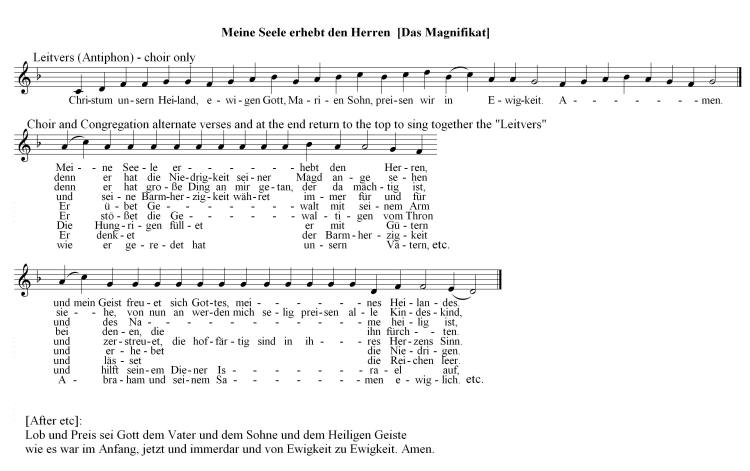
|
| |
|
Melody: |
|
The earliest source given for this specific melody comes from the region of Soest in 1532.
As late as in the works of Samuel Scheidt and Johann Pachelbel, a subtitle can be found attached to the name of this chorale or liturgical chant: “Tonus peregrinus” or “Magnificat toni peregrini”. “Tonus peregrinus” has been translated variously by musicology experts as “the wandering tone”, “the frolicsome tone” (Grove Music Online) and even “Pilgerton” (“the Pilgrims’ tone”) or the “abnormale Psalmodieformel” (“the abnormal formula for psalmody”) (MGG1).. Peter Williams, in his “The Organ Music of J.S. Bach” Cambridge, 1980 and 2003, claims on p. 329: “This is the only canticle to keep intact its original Gregorian melody: the 'tonus peregrinus’….“ However, a closer examination of the sources before 1532 reveal numerous Gregorian chants classified as “tonus peregrinus” which bear hardly any resemblance at all with the chorale melody or the specific liturgical chant under discussion here. There is, however, an important similarity that needs to be pointed out: in chants of a psalmody nature there is a bipartite or dichotomic structure that splits the chant clearly into two parts (in the long history of psalm singing going back to the time of King David, division in the verse/song structure has been observed in many Psalm verses). In each of the two sections there appears a series of repeated notes (called ‘reciting notes’) upon which the additional syllables and words are sung. Generally, in the series of eight or nine tones that had evolved, the note upon which such syllables or words are repeated is the same note in both sections; however, with the “tonus peregrinus”, the repeated note in the second half is not the same note (not at the same pitch) as the first note - it has ‘wandered off and away’ from the usual standard of maintaining the same note in both sections. Example: |
|
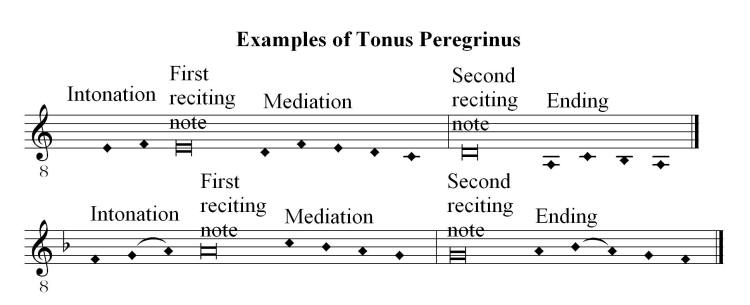
|
|
In short, there is no clear melodic similarity of “Meine Seele erhebet den Herren” with any of the various, earlier Gregorian chants that are classified as being of the “tonus peregrinus” type beyond the simple fact that the repeated note in the second half of the chant must not be the same as the first one (it could actually be on a higher or lower note/pitch, although the latter is more common in occurrence).
Here is the “Magnificat primi toni” (“of the first tone”). This, along with those of the other tones, provided musical materials for elaborations of these themes on the organ by such organist/composers as Dietrich Buxtehude and Johann Pachelbel: |
|

|
|
Some interesting examples of the specific melody or shape of the musical line in the liturgical chant that is referred to as “Meine Seele erhebet den Herren”: |
|
From unspecified hymnals of the 17th century: |
|

|
|

|
| |
|
Tonus peregrinus |
|
(Latin: ‘wandering tone’, ‘frolicsome tone’) German: ‘Pilgerton’ (‘Pilgrim’s Tone’ or ‘Pilgrim’s Psalm’).
The late medieval name for one of the ‘irregular’ psalm tones, that is, one whose tenor, or recitation tone, changes in pitch after the mediation (in this case from a to g). It takes its name either from this characteristic or from its association with Psalm cxiii, In exitu Israel de Aegypto, the ‘Pilgrim’s Psalm’, which is one of the few texts sung to it. The earliest known reference to the tonus peregrinus occurs in the late 9th-century Commemoratio brevis, in which it is called the ‘Tonus novissimus’; its development, therefore, may be considered to postdate that of the traditional eight psalm tones.
Grove Music Online, © Oxford University Press, 2006, acc. 5/6/06 |
| |
|
Reciting notes |
|
In Ambrosian psalmody, recitation can be found on all notes of the scale. In Gregorian practice, in keeping with the restrictions of the modal system, only certain notes were regularly employed: originally, the 5th above the finalis for the authentic (odd-numbered) modes, and the 3rd above for the plagal - except for mode 4, whose reciting note is a. The reiteration of the reciting pitch gives it undoubted prominence, and theorists have made much of its tonal significance (it is sometimes referred to as the ‘dominant’ of the mode). But the ‘system’ introduced with the modes was less than systematic and, before long, changes were made that further diminished the symmetry. Uneasiness about recitation on the note b - perhaps because this degree of the scale was unstable, sometimes sung as b , sometimes as b - led to the raising of the reciting note of the 3rd and 8th modes to c. The settled Gregorian practice is summarized in Table 1. In simple psalmody, the reciting note is normally the same for both half-verses, but among the irregular tones that survived to be used occasionally in the Middle Ages are a few that have a different reciting note before and after the caesura (as do, regularly, the verse tones of responsories and invitatories). It is rare to find psalm tones written out, and difficult therefore to know how widespread were ‘exceptions’ to the rule. The ‘regular’ tone for 6th-mode introits is given in ex.1. However, in the Vatican editions and in some medieval books, the 6th introit-tone, applied to certain verses, appears to have recitation on a in the first part and on f in the second. These cases can be explained as examples where the reciting note does not appear in the second half of the tone, all the syllables having been needed for the second intonation and termination (which consists, exceptionally, of eight elements). The widely used, irregular formula known later as the tonus peregrinus (‘wandering tone’), given here: |
|

|
|
from the Commemoratio brevis, also appears to have two reciting notes; but what is usually seen as recitation on g in the second part can also be understood as extra notes inserted to preserve the text accents of ‘dómino’ and ‘fílios’ in the cadence.
Author: Terence Bailey
Grove Music Online, © Oxford University Press, 2006, acc. 5/6/06 |
| |
|
Magnificat |
|
Following the sermon the Magnificat was sung, either in Latin by the choir or in German by the congregation: Meine Seele erhebt den Herren, a prose text sung to the tonus peregrinus.[Note: to avoid any misunderstanding here it is necessary to realize that the tonus peregrinus does not refer to any specific melody of which there are many that can claim to belong to this category.] The Latin Magnificat continued to be sung in settings that alternated polyphony and chant, in all eight tones and with appropriate antiphons. This gave rise to Magnificat settings for organ in each of these tones, a genre that continued to be composed into the 18th century. Alternation of chant and polyphony gave way to through-composed and concerted settings in the 17th century. In his Latin Magnificat quinti toni Galliculus incorporated vernacular Christmas songs, such as Lieber Joseph, into the texture of his polyphony. Later composers, such as Michael Praetorius, Johann Kuhnau and J.S. Bach, introduced ‘chorale interpolations’ into the text of the canticle as separate movements for use at Christmas Vespers.
Author: Robin A. Leaver
Grove Music Online, © Oxford University Press, 2006, acc. 5/6/06 |
| |
|
Verse structure and chant |
|
The basis of psalmody in both synagogue and Church is the dichotomic structure of its verses. Most psalm verses are constructed of two parallel hemistiches (parallelismus membrorum) and, frequently, each hemistich is further divided into two segments (‘the continuous dichotomy’: Wickes, 1881/R, pp.38–53). But recent research has shown that a great number of verses are actually tripartite (Flender, 1992). Jewish psalmodies preserve this basic verse structure. Yet while the point of the half-verse is carefully marked by a half-cadence formula and a caesura, the end of a verse may sometimes be connected to the beginning of the next (Lachmann, 1940; repr. in the original Ger., 1978, pp.95, 108-10) and the cadential formula delayed to the first pausal point of the following verse. Unlike the usual Gregorian psalmody, where one recitation note (tonus currens, tenor, tuba) is used for both hemistiches, Jewish psalmodies tend to use additional recitation notes, the one for the second half-verse may be higher or lower than that used for the first. When it is lower, the psalmody resembles the Gregorian tonus peregrinus (Herzog and Hajdu, 1968). An initium formula may be missing, or it may begin each verse; sometimes it precedes the second recitation note as well. Jewish chants tend to vary the melodic patterns of the psalmody and to embellish the recitation – hovering around a note rather than mechanically repeating it – and to adorn the cadential points with melismas (see also Avenary, 1953).
Author: Eliyahu Schleifer
Grove Music Online, © Oxford University Press, 2006, acc. 5/6/06 |
| |
|
Alternate CT: Gott sei uns gnädig und barmherzig 9. Psalm |
|
No information on this obscure CT - it seems to be a paraphrase of Psalm 9. |
| |
|
Use of the Chorale Melody by Bach: |
|
Text: Meine Seele erhebet den Herren | EKG: |
|
Ver |
Work |
Mvt. |
Year |
Br |
RE |
KE |
Di |
BC |
Score |
Music Examples |
|
1,2~ |
BWV 10 |
Mvt. 1 |
1724 |
- |
- |
- |
- |
A175:1 |
- |
Mvt. 1 (CCARH) [midi] | Mvt. 1 (Leusink) [ram] |
|
8~ |
BWV 10 |
Mvt. 5 |
1724 |
- |
- |
- |
- |
A175:5 |
- |
Mvt. 5 (CCARH) [midi] | Mvt. 5 (Leusink) [ram] |
|
10,11 |
BWV 10 |
Mvt. 7 |
1724 |
357 |
122 |
358 |
82 |
A175:7 |
PDF |
Mvt. 7 (CCARH) [midi] | Mvt. 7 (MG) [midi] | Mvt. 7 (Leusink) [ram] |
|
BWV 10/1: Luke 1: 46-48
BWV 10/5: (Urbild zu BWV 648); Untexted (but Luke 1:54 is being sung by the two soloists)
BWV 10/7: The words of the doxology are used as an appendage to the Magnificat text |
|
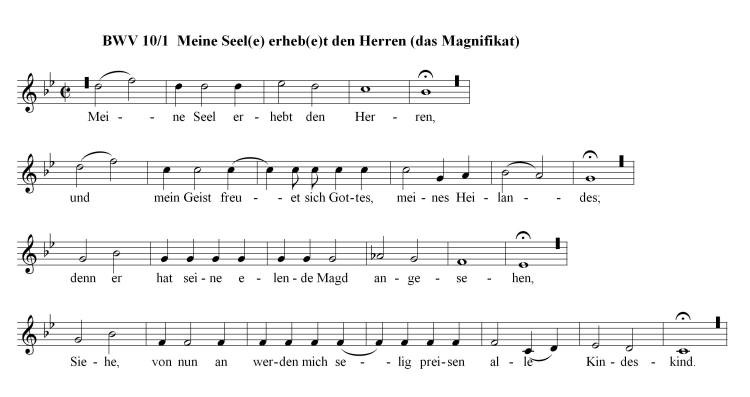
|
|

|
|

|
| |
|
Untexted: |
|
Ver |
Work |
Mvt. |
Year |
Br |
RE |
KE |
Di |
BC |
Score |
Music Examples |
|
- |
BWV 243 |
Mvt. 10 |
1728/31 |
- |
- |
- |
- |
E14:10 |
- |
Mvt. 10 (MG) [midi] |
|
- |
BWV 324 |
- |
? |
130 |
121 |
130 |
- |
F140.1 |
PDF |
Chorale (MG) [midi] |
|
- |
BWV 648 |
- |
1748/49 |
- |
- |
- |
- |
K25 |
- |
Chorale (MG) [midi] |
|
- |
BWV 733 |
- |
1700/17 |
- |
- |
- |
- |
K120 |
- |
Chorale (MG) [midi] |
|
BWV 243/10: Suscepit Israel.
BWV 648: Chorale Prelude for Organ (Schübler Chorale No. 4); An arrangement for organ
of BWV 10/5.
BWV 733: Fuge; some doubt about its authenticity - but nevertheless included in the NBA. |
|
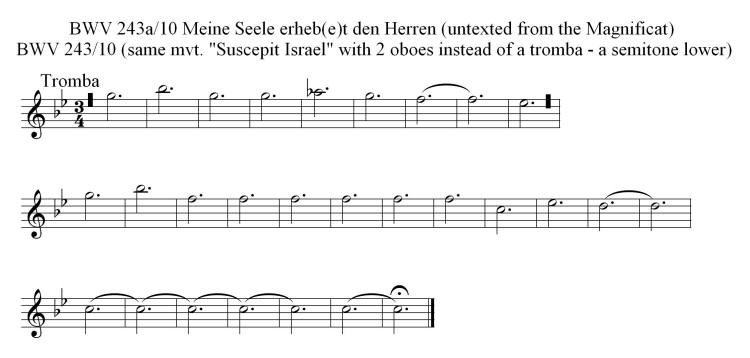
|
|

|
|

|
|

|
| |
|
Text 2: Gott sei uns gnädig und barmherzig 9. Psalm | EKG: |
|
Ver |
Work |
Mvt. |
Year |
Br |
RE |
KE |
Di |
BC |
Score |
Music Examples |
|
- |
BWV 323 |
- |
? |
319 |
120 |
320 |
- |
F140.1 |
PDF |
Chorale (MG) [midi] |
|

|
| |
|
Use of the Chorale Melody by other composers: |
|
Hans Leo Hassler (1564-1612):
Meine Seele erhebt den Herren, 4-pt setting (1608) |
|
Michael Praetorius (1571-1621):
Meine Seele erhebt den Herren, 4-pt setting (1607) |
|
Heinrich Schütz (1585-1672):
Meine Seele erhebt den Herren, Score and Parts |
|
Tobias Zeutschner (1621-1675):
Cantata: Meine Seele erhebt den Herrn Cantus à 13 ou 19 |
|
Werner Fabricius (1633-1679):
Meine Seele erhebt for 9 voice parts |
|
Johann Pachelbel (1653-1706):
Meine Seele erhebt den Herren as, 2 Chorale Preludes for Organ |
|
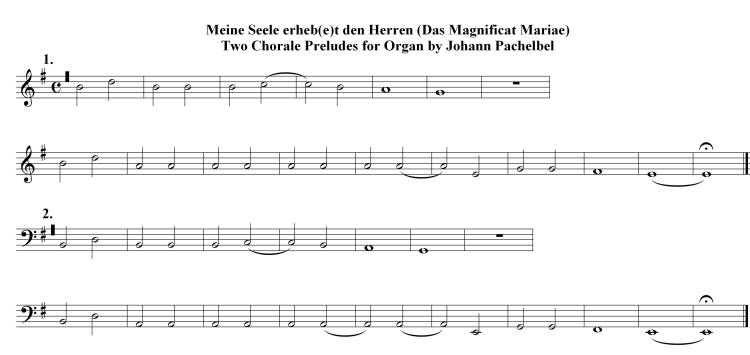
|
|
Friedrich Wilhelm Zachow (1663-1712):
Cantata: Meine Seele erhebt den Herrn [no further information on this reference] |
|
Christian Heinrich Aschenbrenner (1654-1732):
Meine Seele erhebt den Herrn for 5 solo voices, 5-pt. chorus, 4 violas and bassoon |
Johann Gottfried Walther (1684-1748):
Meine Seele erhebt den Herren, Chorale Prelude for Organ Chorale Prelude for Organ |
|
Johann Friedrich Doles,
sr. (1715-1797):
Cantata for Choir, Soloists and Orchestra: Meine Seele erhebt den Herren
|
|
Wolfgang Amadeus Mozart (1756-1791):
Requiem, K. 626
The first phrase and the end of the second are found in the first movement (Te decet hymnus) and in the last movement (Lux eterna). |
|
Martin Traugott Wilhelm Blumner (1827-1901):
Das Lobgesang Mariä, 8-pt. setting for chorus |
|
Camille Saint-Saëns (1835-1921)
6 Duos, Op. 8 : No. 3 : Choral for harmonium & (1858) |
| |
|
Footnotes: |
|
[1] Lobgesang („Song of Praise) Canticum Der Lobgesang der Maria (Mary’s Song of Praise) Das Magnifikat |
| |
|
Sources: NBA, vols. III/2.1 & 2.2 in particular [Bärenreiter, 1954 to present] and the BWV ("Bach Werke Verzeichnis") [Breitkopf & Härtel, 1998]
The PDF files of the Chorales were contributed by Margaret Greentree J.S. Bach Chorales
Software: Capella 2004 Software, version 5.1.
Prepared by Thomas Braatz & Aryeh Oron (May 2006 - October 2019)
Thanks to contributors: Yoav Belinski (November 2014), André Papillon (August 2019) |